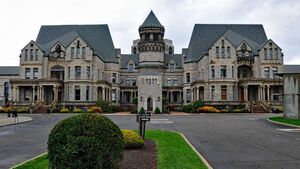Fr Liam Power: The Shawshank Redemption 30 years on

The former Ohio State Reformatory, which was the filming location for movies including The Shawshank Redemption.
The cinematic classic, The Shawshank Redemption, was released 30 years ago in September 1994. The film did not connect with filmgoers at the time of its release. However, it is now one of the most beloved films ever made.
To celebrate the 30th anniversary of its release, Sean Rocks discussed the continued popularity and artistic merits of the movie with Stan Benedict on the Arena programme on RTÉ 1 recently.
It is one of my favourite movies; I have often reflected on the reason for its popularity.
The film presents the hero as a Christ-figure and uses Gospel allegories throughout to explore the central theme. I find it intriguing in a culture so endemically secular that Christian spiritual/ religious themes still resonate so profoundly with millions throughout the world.
The storyline of the film, adapted from a Stephen King novella Rita Hayworth and The Shawshank Redemption, is about a banker, Andy Dufresne, who, though innocent, is sentenced to two consecutive life sentences for murdering his wife and her lover. He is incarcerated in Shawshank State Prison, an oppressive high-walled complex; the grey granite walls symbolise the utter cruelty of, and the dehumanising system that is Shawshank. The prison is a metaphor for a world with so much suffering and cruelty, a world where darkness threatens to destroy any hope of redemption.
Andy Dufresne functions as a paradigmatic Christ or Redeemer-figure. Though innocent he is a victim of the sinfulness of others. Not long after Andy’s arrival at Shawshank, the film begins to portray his Christ-like features. After meeting Warden Norton, Andy stands naked in a cross pose as the guards hose him down. When reflected on in a Gospel light, this ‘baptism’ signifies Andy’s rebirth; descending into the sinful, treacherous halls of the prison, his path as Christ begins.
Warden Norton impresses upon Andy that life in prison is based on the bible and discipline. The warden is truly corrupt, inhumane, and callous. For many reasons, he represents Pharisee figures in the Gospel who are fixated on the law of God, on rules and regulations, and lack any compassion. Andy’s presence raises the spirits of his fellow prisoners. He serves as a beacon of hope, a role model able to fulfil what they can only dream of – hope and redemption.
Andy befriends a fellow prisoner called Red, a fixer “who can get things”. Andy asks him to smuggle in a small rock hammer, implying that he is a craftsman, just as Jesus was. He uses it to dig out a hole through the cell wall, which will ultimately enable him to escape. He hides the hammer in the bible given to him by the warden. We become aware at the end of the film that the Bible where the hammer is concealed opens at the Book of Exodus, which features the liberation and redemption of Hebrew slaves by God.
Through his financial expertise, Andy is able to secure funding from the State to improve the library and phonographic facilities for the inmates. He also secures some cold beers for fellow prisoners. The scene had a miraculous feel to it, suggesting or hinting at the miracle of loaves and fishes, where the disciples experienced healing, dignity restored and inclusion.
One of the most powerful scenes in the film is one where Andy plays a recording of the famous duet from Mozart's opera, The Marriage of Figaro, over the prison PA system. The entire prison is captivated by the music; Red reflects that “those voices soared higher and farther than anybody in a grey place dares to dream. It was like some beautiful bird flapped into our drab little cage and made those walls dissolve away, and for the briefest of moments, every last man in Shawshank felt free.” It was a moment of transfiguration, reminiscent of the transfiguration scene in the Gospels where the disciples caught a glimpse of what Jesus was offering.
The gospel message, of course, pivots not just on the life of Jesus but on his death and resurrection. Andy suffers much in the prison but the final crucifixion is two months in the isolation of the ‘hell hole’. Back in his cell that night, he escapes, going into ‘the tomb’ of a long 500-yard sewage pipe and emerging in a new life (of resurrection) into waters of freedom, standing again in a cross pose but now bathed in light. His resurrection is completed through his “ascension” to the idyllic paradise of a small village on the wide expanse of the blue waters of the Pacific Ocean.
Red later joins Andy to share in this new life of resurrection. They met on the shore just as the risen Jesus met with the disciples on the shore of the Sea of Galilee and invited them to continue his mission.
Meanwhile, Andy’s “disciples”, bereft at the loss of their redeemer, continue to find solace and encouragement from the memory of what he achieved for them. They were writing their own gospel.
The Shawshank Redemption proclaims a profound message of hope that obviously resonates deeply with so many people today. Maybe the film can also reassure Christians of the universal appeal of the Gospel message.






